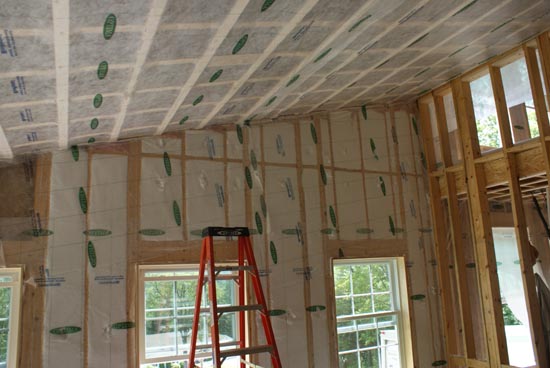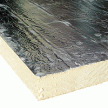Certainteed BIBS Insulation System
Blow-In-Blanket® System with OPTIMA® Fiber Glass Insulation
 Recently I had the pleasure of trying a new insulation system on one of our projects. We’re using the Blow-In-Blanket System with OPTIMA Fiber Glass Wall Insulation by Certainteed for a major addition to a private school.
Recently I had the pleasure of trying a new insulation system on one of our projects. We’re using the Blow-In-Blanket System with OPTIMA Fiber Glass Wall Insulation by Certainteed for a major addition to a private school.
Blown In Wall Insulation
We’ve been using more and more blown in type wall insulation on projects over the last few years especially blown in wet cellulose. The benefits of blown in wall insulation are very obvious when you see it installed just one time. Regardless of the type of material blowing in wall insulation allows for a much tighter cavity with significant reductions in air infiltration.
While we’ve had great success with the wet blown in cellulose there are some folks that have reservations about locking in moisture within the wall cavity. However, our experience has been great with that product and it’s still a very viable insulation option in my opinion. Having said that I was very eager to try this alternative that relies on a dry blown-in product vs the wet procedure we’ve previously tried.
Installation of BIBS with OPTIMA Insulation
Insulating wall and ceiling cavities with the BIBS system is a little different that insulating with a wet spray applied cellulose. The difference being how the insulation is held in place. Prior to filling the wall cavities a breathable cloth like material is applied to the walls as shown in the first photo above. The material is stapled to the wall studs and framing very tightly to ensure the insulation is held tightly in place.
 Installers first stretch out the material and tack it in place with staplers. Once the material is in place and pulled tight they go over all the framing members with an automatic stapler (sounds like a full automatic machine gun!) and install staples every inch or so. This is necessary to help hold the insulation in place without bowing out too much which would make drywall installation near impossible.
Installers first stretch out the material and tack it in place with staplers. Once the material is in place and pulled tight they go over all the framing members with an automatic stapler (sounds like a full automatic machine gun!) and install staples every inch or so. This is necessary to help hold the insulation in place without bowing out too much which would make drywall installation near impossible.
Next the installers cut a small hole in the wall cavity about mid-height and blow in the insulation up and down until the cavity is full. As you can see in the adjacent photo the wall cavity is filled very tight. Once you see how tight it is you realize why they have to install so many staples!
The installers used the same approach with our ceilings (this project we’re doing un-vented cathedral ceilings with the full 14 inches of rafter depth completely filled with insulation. Un-vented ceilings are not something new but some may still say it’s a controversial approach (something for another article one day) but we feel it’s the best approach for low slope (3:12 in our case) roofs.
BIBS with OPTIMA Performance
At the time of this article this project is still under construction so time will be the final judge on performance. However, having said that the specifications for this product boast some impressive numbers.
BIBS with OPTIMA boasts an R23 rating for 2×6 framed walls. This is quite impressive when you consider conventional fiberglass batts at around R19 (assuming perfect installation which is impossible) and R21 for wet applied cellulose. When you consider current fuel prices it’s not hard to argue that every last R value point matters and a 10% improvement will likely pay off in the near future.
When it comes to pricing we were actually quoted the same price for both wet applied cellulose and the BIBS system. When you consider the improved R value and the fact that it’s a dry product it’s certainly a front runner in my opinion.
Some might argue that cellulose is a greener product. On a product to product comparison you would be correct because cellulose is over 80% recycled content where the BIBS system is substantially less than that. However, if you consider the long term performance in R value and fuel savings there’s certainly an argument to be made for a tight race. Also, BIBS with OPTIMA has achieved GREENGUARD® Certification for superior indoor air quality performance.
Overall Impression
So far so good! This is the first project that we’ve used the BIBS product on so it’s a bit early to pass judgment. However, from what I’ve seen so far this is a product that’s sure to make a major impact on the building industry and one we’ll definitely use again. After a winter has passed I’ll be sure to report back on how well it’s been performing.


















My very old house had blown-in cellulose installed in the attic in the 90s (over old knob and tube wiring!!). I HATE the stuff. Our house is so dusty, it causes us respiratory problems. I’ve been using fiberglass batting in the walls as we slowly gut the place. I hope to eventually remove the cellulose in the attic, and replace it with more batts.
Perhaps with newer homes, which are more air-tight, blown-in may be OK. But the stuff creates so much dust. And with a forced-air furnace, it was all a nightmare. I’m glad to be rid of it.
Rebecca – This is a completely different system. The BIBS system is encapsulated inside that netting so there’s no place for it to go. Also, this is a fiberglass fiber and not cellulose. So far this system seems very dust free at least during construction.
Todd, are you having trouble with vapor, moisture or mould on the backside of sheetrock? I managed the build on a house two winters ago, and mould has grown on the back of cabinets, wainscotting and even paintings on the wall. Removing sheetrock shows no moisture in the wall but mould on “cloth material”, backside of sheetrock and the back of whatever was on the wall!
Scott – We haven’t had any issues at all. What type of HVAC system are you using? What type of sheathing, house wrap and siding?
BIB with caution.
I have seen moisture problems with this material used in unvented cathedral roof systems. I know of two homes where the entire roof system had to be torn out and a vented systems installed after mold and rot problems developed. Nothing is 100% it seems, and when you have no ventilation, of a roof space, you maybe taking some chances.
In wall cavities it seems to do well, is a bit of mess around duct penetrations in the furnace room I see it leaking out all over the place. Which also occurs if you are adding an outlet of doing plumbing changes or repairs.
I supervise drywall installers and finishers. It seems like the last time we installed drywall over this BIB system we had many screws popping which I attribute to the bulging of the insulation. I am assuming it was over filled.
Getting ready to start another large custom with same system of insulation. To me it looks like potentially the same problems might arise.
It is half inch drywall on 16′ OC framed walls. I am wondering if a more stout drywall like 5/8′ would be better to resist the outward pressure. It really was an issue on that last job.
David – We’ve had to deal with that in the past as well. You need to keep on the GC / insulation folks to NOT overfill. We also use 5/8″ which helps quite a bit. Good luck.
Hi Todd. Is there any reason Membrain couldn’t be used over some other blown in fiberglass with netting to hold it?